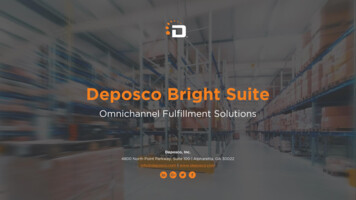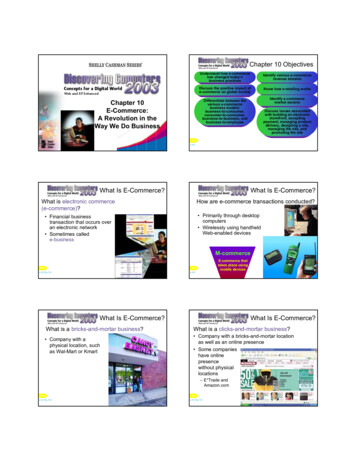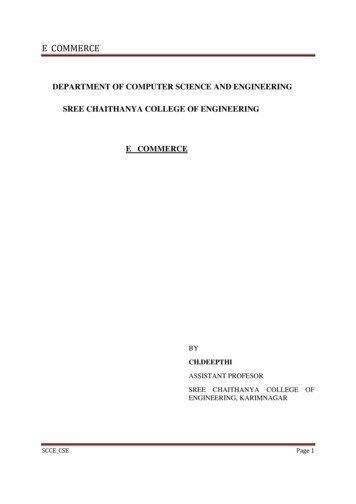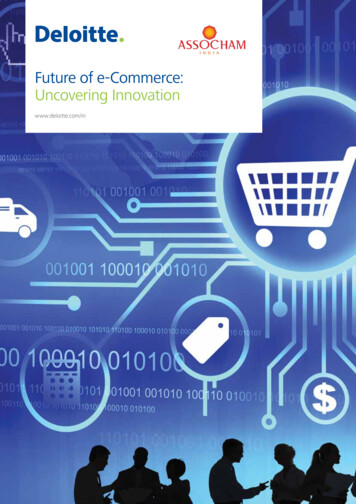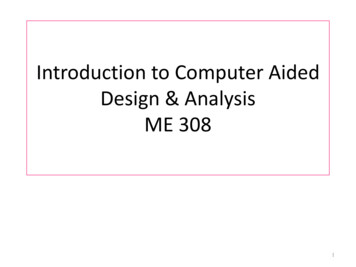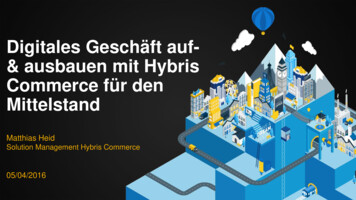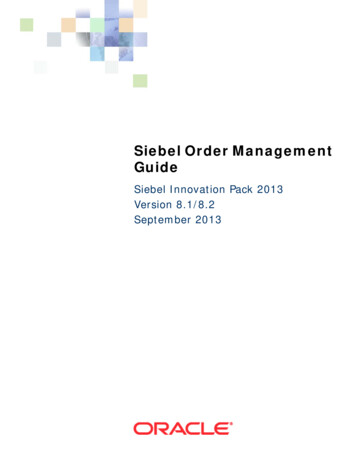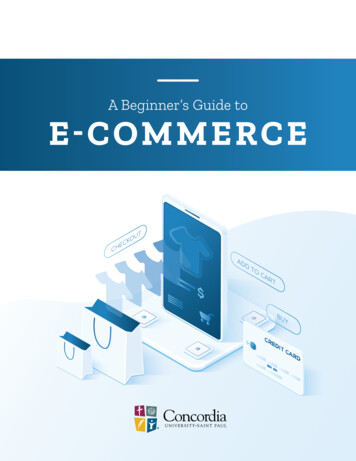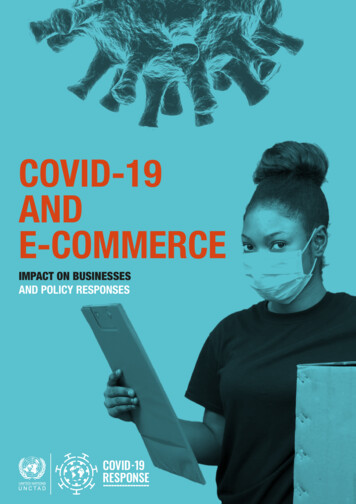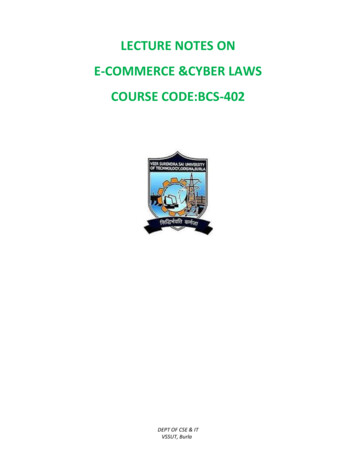
Transcription
LECTURE NOTES ONE-COMMERCE &CYBER LAWSCOURSE CODE:BCS-402DEPT OF CSE & ITVSSUT, Burla
SYLLABUS:Module – IElectronic Commerce: Overview, Definitions, Advantages & Disadvantages of E Commerce,Threats of E-Commerce, Cyber Laws. Technologies: Relationship between E-Commerce andNetworking, Different Types of Networking for E-Commerce, internet, intranet, EDI Systems.Wireless Application Protocol: Definition, Hand Held Devices, Mobility & Commerce. MobileComputing, Wireless Web, Web Security, Infrastructure Requirement for E Commerce. BusinessModels of E-Commerce; Model Based on Transaction Type, Model Based onTransaction Party– B2B, B2C, C2B, C2C, E-Governance.Module – IIConvergence: Technological Advances in Convergence – Types, Convergence and itsimplications, Convergence and Electronic Commerce. Collaborative Computing: Collaborativeproduct development, Content Management: Definition of content, Authoring Tools and ContentManagement, Content – partnership, repositories, convergence, providers Web Traffic & Trafficmanagement: Content Marketing. Call Centre: Definition, Need, Tasks Handled, Mode ofOperation, Equipment, Strength & Weaknesses of Call Centre, Customer Premises Equipment(CPE). Supply Chain Management: E-logistics, Supply Chain Portal, Supply Chain planningTools (SCP Tools), Supply Chain Execution (SCE), SCE – Framework, Internet‘s effect onSupply Chain Power.Module – IIIE-Payment Mechanism; Payment through card system, E-Cheque, E-Cash, E-Payment Threats &Protections, E-Marketing: Home – shopping, E-Marketing, Tele-Marketing Electronic DataInterchange (EDI): Meaning, Benefits, Concepts, Application, EDI Model, protocols (UN EDIFACT / GTDI, ANSIX – 12 Risk of E-Commerce: Overview, Security for E-Commerce,Security Standards, Firewall, Cryptography, Key Management, Password Systems, DigitalCertificates, Digital SignaturesModule – IVEnterprise Resource Planning (ERP): Features, capabilities and Overview of CommercialSoftware, re-engineering work processes for IT applications, Business Process Redesign ,Knowledge Engineering and Data Warehouse. Business Modules: Finance, Manufacturing(Production), Human Resources, Plant Maintenance, Materials, Management, QualityManagement Sales & Distribution ERP Package ERP Market: ERP Market Place, SAP AG,People Soft, BAAN, JD Edwards, Oracle Corporation.EAI(Enterprise application integration)DEPT OF CSE & ITVSSUT, Burla
Chapter-11.1 Electronic Commerce:Electronic commerce, commonly known as E-commerce is trading in products or servicesusing computer networks, such as the Internet.Electronic commerce draws on technologies such as mobile commerce, electronic fundstransfer, supply chain management, Internet marketing, online transaction processing,electronic data interchange (EDI), inventory management systems, and automated datacollection systems.Modern electronic commerce typically uses the World Wide Web for at least one part ofthe transaction's life cycle, although it may also use other technologies such as e-mail.Definition of E-commerce:Sharing business information, maintaining business relationships and conducting businesstransactions using computers connected to telecommunication network is called E-Commerce.1.2 E-Commerce Categories:1. Electronic MarketsPresent a range of offerings available in a market segment so that the purchaser cancompare the prices of the offerings and make a purchase decision.Example: Airline Booking System2. Electronic Data Interchange (EDI) It provides a standardized system Coding trade transactions Communicated from one computer to another without the need for printed orders andinvoices & delays & errors in paper handling It is used by organizations that a make a large no. of regular transactionsExample: EDI is used in the large market chains for transactions with their suppliers3. Internet Commerce It is use to advertise & make sales of wide range of goods & services. This application is for both business to business & business to consumer transactions.DEPT OF CSE & ITVSSUT, Burla
Example: The purchase of goods that are then delivered by post or the booking of ticketsthat can be picked up by the clients when they arrive at the event.1.3 Advantages Of E-commerce: Buying/selling a variety of goods and services from one's home or business Anywhere, anytime transaction Can look for lowest cost for specific goods or service Businesses can reach out to worldwide clients - can establish business partnerships Order processing cost reduced Electronic funds transfer faster Supply chain management is simpler, faster, and cheaper using ecommerce-Can order from several vendors and monitor supplies.-Production schedule and inventory of an organization can be inspected bycooperating supplier who can in-turn schedule their work1.4 Disadvantages Of E-commerce: Electronic data interchange using EDI is expensive for small businesses Security of internet is not very good - viruses, hacker attacks can paralisee-commerce Privacy of e-transactions is not guaranteedDEPT OF CSE & ITVSSUT, Burla
E-commerce de-personalises shopping1.5 Threats of E-commerce:Hackers attempting to steal customer information or disrupt the siteA server containing customer information is stolen.Imposters can mirror your ecommerce site to steal customer moneyAuthorised administrators/users of an ecommerce website downloading hidden activecontent that attacks the ecommerce system.A disaffected employee disrupting the ecommerce system.It is also worth considering where potential threats to your ecommerce site might comefrom, as identifying potential threats will help you to protect your site. Consider:Who may want to access your ecommerce site to cause disruption or steal data; for examplecompetitors, ex-employees, etc.What level of expertise a potential hacker may possess; if you are a small company thatwould not be likely to be considered a target for hackers then expensive, complex securitymay not be needed.1.6 Features of E-Commerce: UbiquityInternet/Web technology is The marketplace is extended beyond traditional availableeverywhere: at work, at home, and boundaries and is removed from a temporal andelsewhere via mobile devices, anytime. geographic location. ―Marketspace‖ is created;shopping can take place anywhere. Customer convenience is enhanced, and shopping costsare reduced. Global reachThe technology reaches Commerce is enabled across cultural and across nationalboundaries, around the earth. national boundaries seamlessly and without modification.―Marketspace‖ includes potentially billions of consumers and millions of businessesworldwide.DEPT OF CSE & ITVSSUT, Burla
Universal standardsThere is one set of There is one set of technical media standards technology standards,namely Internet across the globe. RichnessVideo, audio, and text messages Video, audio, and text marketing messages are arepossible. integrated into a single marketing message and consuming experience. InteractivityThe technology works Consumers are engaged in a dialog that through interaction with theuser. dynamically adjusts the experience to the individual, and makes the consumer a coparticipant in the process of delivering goods to the market. Information densityThe technology Information processing, storage, and reduces information costs and raisesquality. communication costs drop dramatically, while currency, accuracy, and timelinessimprove greatly. Information becomes plentiful, cheap, and accurate. Personalization/CustomizationThe Personalization of marketing messages and technology allows personalized messagesto customization of products and services are be delivered to individuals as well as groups.based on individual characteristics.1.7 Business models of e-commerce:There are mainly 4 types of business models based on transaction party.Business-to-Consumer (B2C)In a Business-to-Consumer E-commerce environment, companies sell their online goods toconsumers who are the end users of their products or services. Usually, B2C E-commerce webshops have an open access for any visitor, meaning that there is no need for a person to login inorder to make any product related inquiry.DEPT OF CSE & ITVSSUT, Burla
Business-to-Business (B2B)In a Business-to-Business E-commerce environment, companies sell their online goods to othercompanies without being engaged in sales to consumers. In most B2B E-commerceenvironments entering the web shop will require a log in. B2B web shop usually containscustomer-specific pricing, customer-specific assortments and customer-specific discounts.Consumer-to-Business (C2B)In a Consumer-to-Business E-commerce environment, consumers usually post their products orservices online on which companies can post their bids. A consumer reviews the bids and selectsthe company that meets his price expectations.DEPT OF CSE & ITVSSUT, Burla
Consumer-to-Consumer (C2C)In a Consumer-to-Consumer E-commerce environment consumers sell their online goods toother consumers. A well-known example is eBay.1.8 E-Governance:E-governance is the application of information and communication technology (ICT) fordelivering government services, exchange of information communication transactions,integration of various stand-alone systems and services between government-to-customer (G2C),government-to-business (G2B), government-to-government (G2G) as well as back officeprocesses and interactions within the entire government framework.Through e-governance, government services will be made available to citizens in a convenient,efficient and transparent manner. The three main target groups that can be distinguished inDEPT OF CSE & ITVSSUT, Burla
governance concepts are government, citizens and businesses/interest groups. In e-governancethere are no distinct boundaries.Business - to - Government (B2G)B2G model is a variant of B2B model. Such websites are used by government to trade andexchange information with various business organizations. Such websites are accredited by thegovernment and provide a medium to businesses to submit application forms to the government.Government - to - Business (G2B)Government uses B2G model website to approach business organizations. Such websites supportauctions, tenders and application submission functionalities.Government - to - Citizen (G2C)Government uses G2C model website to approach citizen in general. Such websites supportauctions of vehicles, machinery or any other material. Such website also provides services likeregistration for birth, marriage or death certificates. Main objectives of G2C website are toreduce average time for fulfilling people requests for various government services.DEPT OF CSE & ITVSSUT, Burla
1.9 Different Types of Networking For E-Commerce:Internet:The Internet is a global network of computers that allows people to send email, view web sites,download files such as mp3 and images, chat, post messages on newsgroups and forums andmuch more.The Internet was created by the Advanced Research Projects Agency (ARPA) of the U.S.government in 1960's and was first known as the ARPANet. At this stage the Internet's firstcomputers were at academic and government institutions and were mainly used for accessingfiles and to send emails. From 1983 onwards the Internet as we know it today started to formwith the introduction of the communication protocol TCP/IP to ARPANet. Since 1983 theInternet has accommodated a lot of changes and continues to keep developing.The last two decades has seen the Internet accommodate such things as network LANs and ATMand frame switched services. The Internet continues to evolve with it becoming available onmobile phones and pagers and possibly on televisions in the future.Advantages of internet:There many advantages to using the internet such as:E-mailEmail is now an essential communication tool in business. It is also excellent for keeping in touchwith family and friends. The advantage to email is that it is free ( no charge per use) when comparedto telephone, fax and postal services.InformationThere is a huge amount of information available on the internet for just about every subjectknown to man, ranging from government law and services, trade fairs and conferences, marketinformation, new ideas and technical support.ServicesMany services are now provided on the internet such as online banking, job seeking andapplications, and hotel reservations. Often these services are not available off-line or cost more.Buy or sell products.The internet is a very effective way to buy and sell products all over the world.DEPT OF CSE & ITVSSUT, Burla
Communities communities of all types have sprung up on the internet. Its a great way to meetup with people of similar interest and discuss common issues.A Leading-Edge ImagePresenting your company or organization as leading-edge shows your customers and prospectivecustomers that you are financially strong, technologically savvy, and ready for the 21st century.And that you care enough about your customers to take advantage of new technologies for theirbenefit. And finally that you have the resources to support your clients in the most beneficialmanner possible.More and more advertisers on television, radio, magazines, and newspapers are including a Webaddress. Now is the time to avoid playing catch-up later.Improved Customer ServiceThe companies are available to their customers 24 hours a day, 7 days a week. The Internet neversleeps. Whenever customer needs information about any company, products or services, they canaccess the company‘s Web Page.Market ExpansionThe Internet is a global system. Latest estimates are that there are about 40 million people withaccess to the Internet, and this number is growing every day. By simply posting a Web Page youare also addressing International markets.Low Cost MarketingImagine developing a full color brochure without having to incur the costs of proofs, printers,wasted paper, long lead times between revisions, and more. Then imagine a full color product orservices brochure that is interactive and which incorporates text, graphics, audio, and/or video.One that can be immediately updated without incurring the usual costs of product materialupdates.Low Cost SellingWithout the cost of direct selling potential customers can get detailed information about yourproducts or services at any time. And they can easily order your products over the Internet, orrequest additional information be sent to them via a request form on your Web page.Lower Communication CostsYour time, and your employees time, is valuable. Most businesses and organizations spend timeanswering the same questions over and over again. With a Web page you can make the answersDEPT OF CSE & ITVSSUT, Burla
available to everyone immediately. You can also update your Wed page with new informationquickly and easily.Intranet:An intranet is a computer network that uses Internet Protocol technology to shareinformation, operational systems, or computing services within an organization. This termis used in contrast to extranet, a network between organizations, and instead refers to anetwork within an organization.The objective is to organize each individual's desktop with minimal cost, time and effort tobe more productive, cost efficient, timely, and competitive.An intranet may host multiple private websites and constitute an important component andfocal point of internal communication and collaboration.Any of the well known Internet protocols may be found in an intranet, such as HTTP (webservices), SMTP (e-mail), and FTP (file transfer protocol). Internet technologies are oftendeployed to provide modern interfaces to legacy information systems hosting corporatedata.Uses of Intranet:Increasingly, intranets are being used to deliver tools, e.g. collaboration (to facilitate workingin groups and teleconferencing) or sophisticated corporate directories, sales and customerrelationship management tools, project management etc., to advance productivity.Intranets are also being used as corporate culture-change platforms. For example, largenumbers of employees discussing key issues in an intranet forum application could lead tonew ideas in management, productivity, quality, and other corporate issues.In large intranets, website traffic is often similar to public website traffic and can be betterunderstood by using web metrics software to track overall activity. User surveys alsoimprove intranet website effectiveness. Larger businesses allow users within their intranet toaccess public internet through firewall servers. They have the ability to screen messagescoming and going keeping security intact.When part of an intranet is made accessible to customers and others outside the business, thatpart becomes part of an extranet. Businesses can send private messages through the publicDEPT OF CSE & ITVSSUT, Burla
network, using special encryption/decryption and other security safeguards to connect onepart of their intranet to another.Intranet user-experience, editorial, and technology teams work together to produce in-housesites. Most commonly, intranets are managed by the communications, HR or CIOdepartments of large organizations, or some combination of these.Because of the scope and variety of content and the number of system interfaces, intranets ofmany organizations are much more complex than their respective public websites. Intranetsand their use are growing rapidly.Advantages:Workforce productivity: Intranets can help users to locate and view information faster anduse applications relevant to their roles and responsibilities. With the help of a web browserinterface, users can access data held in any database the organization wants to makeavailable, anytime and — subject to security provisions — from anywhere within thecompany workstations, increasing employees' ability to perform their jobs faster, moreaccurately, and with confidence that they have the right information.Time: Intranets allow organizations to distribute information to employees on an as-neededbasis; Employees may link to relevant information at their convenience, rather than beingdistracted indiscriminately by email.Communication: Intranets can serve as powerful tools for communication within anorganization, vertically strategic initiatives that have a global reach throughout theorganization. By providing this information on the intranet, staff have the opportunity to keepup-to-date with the strategic focus of the organization. Some examples of communicationwould be chat, email, and/or blogs. A great real world example of where an intranet helped acompany communicate is when Nestle had a number of food processing plants inScandinavia. Their central support system had to deal with a number of queries every day.Web publishing: allows cumbersome corporate knowledge to be maintained and easilyaccessed throughout the company using hypermedia and Web technologies. Examplesinclude: employee manuals, benefits documents, company policies, business standards, newsfeeds, and even training, can be accessed using common Internet standards (Acrobat files,DEPT OF CSE & ITVSSUT, Burla
Flash files, CGI applications). Because each business unit can update the online copy of adocument, the most recent version is usually available to employees using the intranet.Business operations and management: Intranets are also being used as a platform fordeveloping and deploying applications to support business operations and decisions acrossthe internetworked enterprise.Cost-effective: Users can view information and data via web-browser rather thanmaintaining physical documents such as procedure manuals, internal phone list andrequisition forms. This can potentially save the business money on printing, duplicatingdocuments, and the environment as well as document maintenance overhead.Enhance collaboration: Information is easily accessible by all authorised users, whichenables teamwork.Cross-platform capability: Standards-compliant web browsers are available for Windows,Mac, and UNIX.Built for one audience: Many companies dictate computer specifications which, in turn,may allow Intranet developers to write applications that only have to work on one browser(no cross-browser compatibility issues).Promote common corporate culture: Every user has the ability to view the sameinformation within the Intranet.Immediate updates: When dealing with the public in any capacity, laws, specifications, andparameters can change. Intranets make it possible to provide your audience with "live"changes so they are kept up-to-date, which can limit a company's liability.Supports a distributed computing architecture: The intranet can also be linked to acompany‘s management information system, for example a time keeping system.1.10 Wireless Application Protocol:WAP is a technical standard for accessing information over a mobile wireless network.A WAP browser is a web browser for mobile devices such as mobile phones that uses theprotocol.WAP is a specification for a set of communication protocols to standardize the way thatwireless devices, such as cellular telephones and radio transceivers, can be used for Internetaccess, including e-mail, the World Wide Web, newsgroups, and instant messaging.DEPT OF CSE & ITVSSUT, Burla
The WAP layers are:Wireless Application Environment (WAE)Wireless Session Layer (WSL)Wireless Transport Layer Security(WTLS)Wireless Transport Layer (WTP)Web security:It is a branch of Information Security that deals specifically with security of websites, webapplications and web services.At a high level, Web application security draws on the principles of application security butapplies them specifically to Internet and Web systems. Typically web applications aredeveloped using programming languages such as PHP, Java EE, Java, Python, Ruby,ASP.NET, C#, VB.NET or Classic ASP.DEPT OF CSE & ITVSSUT, Burla
Chapter-22.1 Technological convergence:Technological convergence is the tendency that as technology changes, differenttechnological systems sometimes evolve toward performing similar tasks.Digital convergence refers to the convergence of four industries into one conglomerate,ITTCE (Information Technologies, Telecommunication, Consumer Electronics, andEntertainment).Previously separate technologies such as voice data and productivityapplications, and video can now share resources and interact with each othersynergistically.Telecommunications convergence, network convergence or simply convergence are broadterms used to describe emerging telecommunications technologies, and networkarchitecture used to migrate multiple communications services into a single network.Convergence in this instance is defined as the interlinking of computing and otherinformation technologies, media content, and communication networks that has arisen asthe result of the evolution and popularization of the Internet as well as the activities,products and services that have emerged in the digital media space.Convergent services, such as VoIP, IPTV, Mobile TV, Smart TV, and others, tend toreplace the older technologies and thus can disrupt markets. IP-based convergence isinevitable and will result in new service and new demand in the market.2.2 Technology Implications:Convergent solutions include both fixed-line and mobile technologies. Recent examples of new,convergent services include:Using the Internet for voice telephonyVideo on demandFixed-mobile convergenceMobile-to-mobile convergenceDEPT OF CSE & ITVSSUT, Burla
Location-based servicesIntegrated products and bundlesConvergent technologies can integrate the fixed-line with mobile to deliver convergent solutions.Convergent technologies include:IP Multimedia SubsystemSession Initiation ProtocolIPTVVoice over IPVoice call continuityDigital video broadcasting - handheld2.3 Collaborative Product Development:CPD is a business strategy, work process and collection of software applications thatfacilitates different organizations to work together on the development of a product. It isalso known as collaborative product definition management (cPDM).Collaborative Product Development helps individual users and companies manage, shareand view your CAD projects without the cost and complexity of purchasing an entire PDMor PLM solution. CPD comes in the form of a Software as a service delivery model, whichallows for rapid iterations and little or no downloads and installs.Exactly what technology comes under this title does vary depending on whom one asks;however, it usually consists of the Product Lifecycle Management (PLM) areas of: ProductData Management (PDM); Product visualization; team collaboration and conferencingtools; and supplier sourcing software. It is generally accepted as not including CADgeometry tools, but does include data translation technology.Technologies and methods used:Clearly general collaborative software such as email and chat (instant messaging) is used withinthe CPD process. One important technology is application and desktop sharing, allowing oneperson to view what another person is doing on a remote machine. For CAD and productvisualization applications an ‗appshare‘ product that supports OpenGL graphics is required.Another common application is Data sharing via Web based portals.DEPT OF CSE & ITVSSUT, Burla
Specific to product dataWith product data an important addition is the handling of high volumes of geometry andmetadata. Exactly what techniques and technology is required depends on the level ofcollaboration being carried out and the commonality (or lack thereof) of the partner sites‘systems.Specific to PLM and CAx collaborationCollaboration using PLM and CAx tools requires technology to support the needs of:1. People: Personnel of different disciplines and skill levels;2. Organizations: Organizations throughout an enterprise or extended enterprise withdifferent rules, processes and objectives;3. Data: Data from different sources in different formats.Appropriate technologies are required to support collaboration across these boundaries. PeopleEffective PLM collaboration will typically require the participation of people who do nothave high level CAD skills. This requires improved user interfaces including tailorable userinterfaces that can be tailored to the skill level and specialty of the user.Improved visualization capabilities, especially those that provide a meaningful view ofcomplex information such as the results of a fluid flow analysis will leverage the value ofall participants in the collaboration process. Effective collaboration requires that aparticipant be freed from the burden of knowing the intent history typically imbeddedwithin and constricting the use of parametric models. OrganizationsCommunity collaboration requires that companies, suppliers, and customers shareinformation in a secure environment, ensure compliance with enterprise and regulatoryrules and enforce the process management rules of the community as well as the individualorganizations.DEPT OF CSE & ITVSSUT, Burla
DataThe most basic collaboration data need is the ability to operate in a MultiCADenvironment. That is, however, only the beginning. Models from multiple CAD sourcesmust be assembled into an active digital mockup allowing change and/or design in context.2.4 Content Management System:A content management system (CMS) is a computer application that allows publishing,editing and modifying content, organizing, deleting as well as maintenance from a centralinterface. Such systems of content management provide procedures to manage workflowin a collaborative environment.CMSs are often used to run websites containing blogs, news, and shopping. Manycorporate and marketing websites use CMSs. CMSs typically aim to avoid the need forhand coding, but may support it for specific elements or entire pages.Main features of CMS:The function and use of content management systems is to store and organize files, andprovide version-controlled access to their data. CMS features vary widely. Simplesystems showcase a handful of features, while other releases, notably enterprise systems,offer more complex and powerful functions. Most CMS include Web-based publishing,format management, revision control (version control), indexing, search, and retrieval.The CMS increments the version number when new updates are added to an alreadyexisting file. Some content management systems also support the separation of contentand presentation.A CMS may serve as a central repository containing documents, movies, pictures, phonenumbers, scientific data. CMSs can be used for storing, controlling, revising,semantically enriching and publishing documentation.DEPT OF CSE & ITVSSUT, Burla
The content management system (CMS) has two elements: Content management application (CMA) is the front-end user interface that allows a user,even with limited expertise, to add, modify and remove content from a Web site withoutthe intervention of a Webmaster. Content delivery application (CDA) compiles that information and updates the Web site.2.5 Web Traffic:Web traffic is the amount of data sent and received by visitors to a web site.Web traffic is measured to see the popularity of web sites and individual pages or sections withina site. This can be done by viewing the traffic statistics found in the web server log file, anautomatically generated list of all the pages served. A hit is generated when any file is served.The following types of information are often collated when monitoring web traffic:The number of visitors.The average number of page views per visitor – a high number would indicate that theaverage visitors go deep inside the site, possibly because they like it or find it useful.Average visit duration – the total length of a user's visit. As a rule the more time theyspend the more they're interested in your company and are more prone to contact.Average page duration – how long a page is viewed for. The mo
1.7 Business models of e-commerce: There are mainly 4 types of business models based on transaction party. Business-to-Consumer (B2C) In a Business-to-Consumer E-commerce environment, companies sell their online goods to consumers who are the end users of their products

